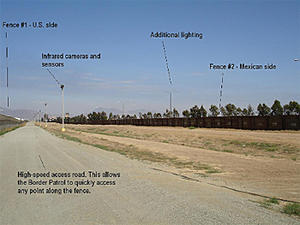Border security$800 million for 53-mile of border fence (it was supposed to be 655 miles)
The original plan of the Secure Border Initiative (SBINet) called for spending $833 million to build a virtual fence — a system of sophisticated sensors, cameras, and other barriers — along 655 miles of U.S.-Mexico border in Arizona, New Mexico, and a slice of Texas, at a cost of about $1.2 million per mile; Boeing, the prime contractor, used $800 million to build the system along only 53 miles of border at a cost of $15.1 million per mile; the virtual fence’s technology is now judged a failure

A stretch of the fenced border area // Source: zdnet.com
U.S. taxpayers have shelled out at least $15.1 million per mile for fifty-three miles of “virtual fence” built to secure the U.S.-Mexico border, more than twelve times the original estimate.
The federal government set aside $833 million for the fence of cameras, sensors, and other barriers in 2007, and the vast majority of that money, at least $800 million, has been spent on a sliver, in Arizona, of the 1,950-mile southern border. About $20.9 million has been used on the U.S.-Canada border.
Rep. Chris Carney (D-Pennsylvania)., chairman of a House Homeland Security subcommittee, said the money was supposed to buy virtual fence for 655 miles of border in Arizona, New Mexico, and a slice of Texas, at a cost of about $1.2 million per mile.
“We are guardians of the taxpayers’ money and someone said yes to this, we said yes to this and it’s not what was originally sold,” Carney said.
AP reports that the totals come from the House Homeland Security Committee, which got them from DHS. Customs and Border Protection (CBP) confirmed the figures.
The fence, developed as part of a border security plan under President George W. Bush, was supposed to monitor most of the southern border with Mexico by 2011. Now, the fifty-three miles in Arizona is expected to be done by the end of the year.
Additionally, the expected capabilities of the virtual fence have shrunk, said Randolph Hite, a Government Accountability Office official. “It’s hard to redirect an iceberg once it’s started moving in one direction, and that’s what we are facing,” Hite said.
DHS has suspended the project while it decides what to do next. Several officials acknowledged some good has come from the project, but they questioned the cost for those capabilities.
Carney urged the department to “find other means to secure the border in a timely and effective manner.”
Roger Krone, an executive with virtual fence contractor Boeing, disagreed with portrayals of the spending. He said only $155 million was spent for the deployment of technology to monitor fifty-five miles of the Arizona border, a rate of $2.8 million a mile.
Krone said of the $828 million spent on the fence, $484 million was for nonrecurring costs, on design, development, supplier, and program management and software design and development.
Mark Borkowski, Customs and Border Protections executive director of the Secure Border Initiative, said it is unknown whether the technology will be used to secure other parts of the border.
“The question is, is that really the right technology … or can we come up with something that’s a little bit more rational, that is tailored to each area of the border,” Borkowski said.
